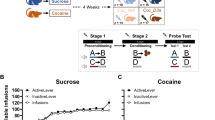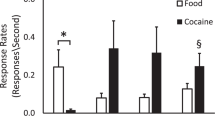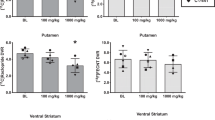Abstract
Augmentation of cue exposure (extinction) therapy with cognitive-enhancing pharmacotherapy may offer an effective strategy to combat cocaine relapse. To investigate this possibility at the preclinical level, rats and squirrel monkeys were trained to self-administer cocaine paired with a brief visual cue. Lever pressing was subsequently extinguished by withholding cocaine injections while maintaining response-contingent presentations of the cue. The glycine partial agonist D-cycloserine (DCS; 15 and 30 mg/kg in rats, 3 and 10 mg/kg in monkeys) was evaluated for its effects on the rate of extinction and subsequent reacquisition of cocaine self-administration. Compared with vehicle, pretreatment with 30 mg/kg DCS 0.5 h before extinction training reduced the number of responses and latency to reach the extinction criterion in rats, but neither dose of DCS altered these measures in monkeys. In both species, pretreatment with the higher dose of DCS before extinction training significantly attenuated reacquisition of cocaine self-administration compared with either extinction training in the absence of DCS or DCS in the absence of explicit extinction. Furthermore, treatment with 30 mg/kg DCS accompanied by brief handling (a stress induction) immediately after but not 6 h after extinction training attenuated reacquisition of cocaine self-administration in rats. No adverse effects of 10 mg/kg DCS were evident in quantitative observational studies in monkeys. The results suggest that DCS augmented consolidation of extinction learning to deter reacquisition of cocaine self-administration in rats and monkeys. The results suggest that DCS combined with exposure therapy may constitute a rational strategy for the clinical management of cocaine relapse.
Similar content being viewed by others
Log in or create a free account to read this content
Gain free access to this article, as well as selected content from this journal and more on nature.com
or
References
Botreau F, Paolone G, Stewart J (2006). D-cycloserine facilitates extinction of a cocaine-induced conditioned place preference. Behav Brain Res 172: 173–178.
Bouton ME (2004). Context and behavioral processes in extinction. Learn Mem 11: 485–494.
Bouton ME, Vurbic D, Woods AM (2008). D-cycloserine facilitates context-specific fear extinction learning. Neurobiol Learn Mem 90: 504–510.
Bowery NG (1987). Glycine-binding sites and NMDA receptors in brain. Nature 326: 338.
Conklin CA, Tiffany ST (2002). Applying extinction research and theory to cue-exposure addiction treatments. Addiction 97: 155–167.
Dash PK, Hebert AE, Runyan JD (2004). A unified theory for systems and cellular memory consolidation. Brain Res Brain Res Rev 45: 30–37.
Davis M, Ressler K, Rothbaum BO, Richardson R (2006). Effects of D-cycloserine on extinction: translation from preclinical to clinical work. Biol Psychiatry 60: 369–375.
Dutra L, Stathopoulou G, Basden SL, Leyro TM, Powers MB, Otto MW (2008). A meta-analytic review of psychosocial interventions for substance use disorders. Am J Psychiatry 165: 179–187.
Feltenstein MW, See RE (2007). NMDA receptor blockade in the basolateral amygdala disrupts consolidation of stimulus-reward memory and extinction learning during reinstatement of cocaine-seeking in an animal model of relapse. Neurobiol Learn Mem 88: 435–444.
Franklin TR, Acton PD, Maldjian JA, Gray JD, Croft JR, Dackis CA et al (2002). Decreased gray matter concentration in the insular, orbitofrontal, cingulate, and temporal cortices of cocaine patients. Biol Psychiatry 51: 134–142.
Goeders NE, Clampitt DM (2002). Potential role for the hypothalamo-pituitary-adrenal axis in the conditioned reinforcer-induced reinstatement of extinguished cocaine seeking in rats. Psychopharmacology (Berl) 161: 222–232.
Guijarro JZ, Tiba PA, Ferreira TL, Kawakami SE, Oliveira MG, Suchecki D (2007). Effects of brief and long maternal separations on the HPA axis activity and the performance of rats on context and tone fear conditioning. Behav Brain Res 184: 101–108.
Haney M, Spealman R (2008). Controversies in translational research: drug self-administration. Psychopharmacology (Berl) 199: 403–419.
Havermans RC, Jansen AT (2003). Increasing the efficacy of cue exposure treatment in preventing relapse of addictive behavior. Addict Behav 28: 989–994.
Hofmann SG, Meuret AE, Smits JA, Simon NM, Pollack MH, Eisenmenger K et al (2006). Augmentation of exposure therapy with D-cycloserine for social anxiety disorder. Arch Gen Psychiatry 63: 298–304.
Hood WF, Compton RP, Monahan JB (1989). D-cycloserine: a ligand for the N-methyl-D-aspartate coupled glycine receptor has partial agonist characteristics. Neurosci Lett 98: 91–95.
Hui IR, Hui GK, Roozendaal B, McGaugh JL, Weinberger NM (2006). Posttraining handling facilitates memory for auditory-cue fear conditioning in rats. Neurobiol Learn Mem 86: 160–163.
Kantak KM, Udo T, Ugalde F, Luzzo C, Di PN, Eichenbaum HB (2005). Influence of cocaine self-administration on learning related to prefrontal cortex or hippocampus functioning in rats. Psychopharmacology (Berl) 181: 227–236.
Kelley AE (2004). Memory and addiction: shared neural circuitry and molecular mechanisms. Neuron 44: 161–179.
Langton JM, Richardson R (2008). D-cycloserine facilitates extinction the first time but not the second time: an examination of the role of NMDA across the course of repeated extinction sessions. Neuropsychopharmacol 33: 3096–3102.
Ledgerwood L, Richardson R, Cranney J (2003). Effects of D-cycloserine on extinction of conditioned freezing. Behav Neurosci 117: 341–349.
Ledgerwood L, Richardson R, Cranney J (2004). D-cycloserine and the facilitation of extinction of conditioned fear: consequences for reinstatement. Behav Neurosci 118: 505–513.
Ledgerwood L, Richardson R, Cranney J (2005). D-cycloserine facilitates extinction of learned fear: effects on reacquisition and generalized extinction. Biol Psychiatry 57: 841–847.
Lee JL, Gardner RJ, Butler VJ, Everitt BJ (2009). D-cycloserine potentiates the reconsolidation of cocaine-associated memories. Learn Mem 16: 82–85.
Lu L, Koya E, Zhai H, Hope BT, Shaham Y (2006). Role of ERK in cocaine addiction. Trends Neurosci 29: 695–703.
Makris N, Gasic GP, Seidman LJ, Goldstein JM, Gastfriend DR, Elman I et al (2004). Decreased absolute amygdala volume in cocaine addicts. Neuron 44: 729–740.
Matsuoka N, Aigner TG (1996). D-cycloserine, a partial agonist at the glycine site coupled to N-methyl-D-aspartate receptors, improves visual recognition memory in rhesus monkeys. J Pharmacol Exp Ther 278: 891–897.
McGaugh JL, Roozendaal B (2009). Drug enhancement of memory consolidation: historical perspective and neurobiological implications. Psychopharmacology (Berl) 202: 3–14.
Milton AL, Lee JL, Butler VJ, Gardner R, Everitt BJ (2008). Intra-amygdala and systemic antagonism of NMDA receptors prevents the reconsolidation of drug-associated memory and impairs subsequently both novel and previously acquired drug-seeking behaviors. J Neurosci 28: 8230–8237.
Norberg MM, Krystal JH, Tolin DF (2008). A meta-analysis of D-cycloserine and the facilitation of fear extinction and exposure therapy. Biol Psychiatry 63: 1118–1126.
O’Brien CP (2003). Research advances in the understanding and treatment of addiction. Am J Addict 12 (Suppl 2): S36–S47.
O’Brien CP, Childress AR, McLellan T, Ehrman R (1990). Integrating systemic cue exposure with standard treatment in recovering drug dependent patients. Addict Behav 15: 355–365.
Otto MW, McHugh RK, Kantak KM (2009a). Combined pharmacotherapy and cognitive-behavioral therapy for anxiety disorders: medication effects, glucocorticoids, and attenuated treatment outcomes. Clinical Psychology: Science and Practice (in press [a]).
Otto MW, Tolin DF, Simon NM, Pearlson GD, Basden S, Meunier SA et al (2009b). Efficacy of d-cycloserine for enhancing response to cognitive-behavior therapy for panic disorder. Biol Psychiatry (in press [b]).
Paolone G, Botreau F, Stewart J (2009). The facilitative effects of D-cycloserine on extinction of a cocaine-induced conditioned place preference can be long lasting and resistant to reinstatement. Psychopharmacology (Berl) 202: 403–409.
Platt DM, Carey G, Spealman RD (2005). Intravenous self-administration techniques in monkeys. Curr Protoc Neurosci Chapter Chapter 9 Unit 9.21.
Platt DM, Rowlett JK, Spealman RD (2000). Dissociation of cocaine-antagonist properties and motoric effects of the D1 receptor partial agonists SKF 83959 and SKF 77434. J Pharmacol Exp Ther 293: 1017–1026.
Platt DM, Rowlett JK, Spealman RD (2001). Modulation of cocaine and food self-administration by low- and high-efficacy D1 agonists in squirrel monkeys. Psychopharmacology (Berl) 157: 208–216.
Quirk GJ, Mueller D (2008). Neural mechanisms of extinction learning and retrieval. Neuropsychopharmacol 33: 56–72.
Ressler KJ, Rothbaum BO, Tannenbaum L, Anderson P, Graap K, Zimand E et al (2004). Cognitive enhancers as adjuncts to psychotherapy: use of D-cycloserine in phobic individuals to facilitate extinction of fear. Arch Gen Psychiatry 61: 1136–1144.
Roman O, Seres J, Pometlova M, Jurcovicova J (2004). Neuroendocrine or behavioral effects of acute or chronic emotional stress in Wistar Kyoto (WKY) and spontaneously hypertensive (SHR) rats. Endocr Regul 38: 151–155.
Rupniak NM, Duchnowski M, Tye SJ, Cook G, Iversen SD (1992). Failure of D-cycloserine to reverse cognitive disruption induced by scopolamine or phencyclidine in primates. Life Sci 50: 1959–1962.
Schneider JS, Tinker JP, Van VM, Giardiniere M (2000). Effects of the partial glycine agonist D-cycloserine on cognitive functioning in chronic low dose MPTP-treated monkeys. Brain Res 860: 190–194.
Thanos PK, Bermeo C, Wang GJ, Volkow ND (2009). D-cycloserine accelerates the extinction of cocaine-induced conditioned place preference in C57bL/c mice. Behav Brain Res 199: 345–349.
Walker DL, Ressler KJ, Lu KT, Davis M (2002). Facilitation of conditioned fear extinction by systemic administration or intra-amygdala infusions of D-cycloserine as assessed with fear-potentiated startle in rats. J Neurosci 22: 2343–2351.
Winer B (1971). Statistical Principles in Experimental Design. McGraw-Hill Inc. : New York.
Woods AM, Bouton ME (2006). D-cycloserine facilitates extinction but does not eliminate renewal of the conditioned emotional response. Behav Neurosci 120: 1159–1162.
Yang YL, Chao PK, Ro LS, Wo YY, Lu KT (2007). Glutamate NMDA receptors within the amygdala participate in the modulatory effect of glucocorticoids on extinction of conditioned fear in rats. Neuropsychopharmacol 32: 1042–1051.
Zweifel LS, Argilli E, Bonci A, Palmiter RD (2008). Role of NMDA receptors in dopamine neurons for plasticity and addictive behaviors. Neuron 59: 486–496.
Acknowledgements
This study was funded by Grants R01 DA024315, R01 DA11054, P51 RR00168, and T32 MH020064. The content is solely the responsibility of the authors and does not necessarily represent the official views of the National Institutes of Health. We thank Ms Kristen Bano, Ms Shana Langer, Ms Nicole McKenzie, Ms Laura Teixeira, and Ms Audrey Wells for assistance with data collection.
Author information
Authors and Affiliations
Corresponding author
Additional information
Disclosure
The authors declare that BND, CA-M, DP, RS, and JS, except for income received from their primary employers, have received no financial support or compensation from any individual or corporate entity over the past 3 years for research or professional service and there are no personal financial holdings that could be perceived as constituting a potential conflict of interest. The authors declare that over the past 3 years, KK has received consulting fees and stock options from Yaupon Therapeutics, the developer of therapeutics for central nervous system disorders and that MO has received consulting fees and grant support from Organon (Schering-Plough) and advisory board service for Jazz Pharmaceuticals, the developers of therapeutics for central nervous system disorders.
Supplementary Information accompanies the paper on the Neuropsychopharmacology website (http://www.nature.com/npp)
Supplementary information
Rights and permissions
About this article
Cite this article
Nic Dhonnchadha, B., Szalay, J., Achat-Mendes, C. et al. D-cycloserine Deters Reacquisition of Cocaine Self-Administration by Augmenting Extinction Learning. Neuropsychopharmacol 35, 357–367 (2010). https://doi.org/10.1038/npp.2009.139
Received:
Revised:
Accepted:
Published:
Issue date:
DOI: https://doi.org/10.1038/npp.2009.139
Keywords
This article is cited by
-
Molecular and circuit mechanisms regulating cocaine memory
Cellular and Molecular Life Sciences (2020)
-
Spermidine, a positive modulator of the NMDA receptor, facilitates extinction and prevents the reinstatement of morphine-induced conditioned place preference in mice
Psychopharmacology (2020)
-
Bidirectional effects of inhibiting or potentiating NMDA receptors on extinction after cocaine self-administration in rats
Psychopharmacology (2014)
-
Post-retrieval extinction as reconsolidation interference: methodological issues or boundary conditions?
Psychopharmacology (2013)
-
A randomized, placebo-controlled laboratory study of the effects of d-cycloserine on craving in cocaine-dependent individuals
Psychopharmacology (2013)



